
Western Juniper - Lumber Products
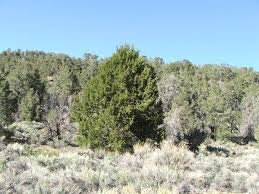
Source: http://www.laspilitas.com/
Establishing Engineering Design Values for Western Juniper
April 10th, 2018 OSU press release - New Standards for Western Juniper Wood Boost Market Potential for Invasive Tree
Design Values were Approved February 1, 2018! See Allowable Property Values for Western Juniper (2x4 through 2x14 and wider); decking spans were approved April 26, 2018.
UPDATE: April 6, 2018 - Mechanical Property Assessment for Establishing Design Values of Western Juniper is now published in the April edition of Wood & Fiber Science.
Western juniper (Juniperus occidentalis) acreage in the Great Basin of the western United States has increased dramatically in the past century. In Oregon alone, western juniper woodlands have expanded from approximately 607,000 hectares (1.5 million acres) in 1930 to about 2.6 million hectares (6.5 million acres) today. As juniper trees dominate a site, erosion increases, stream flows are reduced, forage production declines, and wildlife habitat (e.g., for the sage grouse in particular) is altered. Thinning juniper stands has been shown to help restore rangelands. However such efforts are economically marginal at best in the absence of markets for juniper logs.
Over the past century, numerous small-scale efforts have been undertaken to develop markets for western juniper. Given that juniper is a naturally durable wood species, one market of particular interest has been sign posts and guard rail posts. However, for an agency such as the Oregon Department of Transportation (ODOT) to purchase juniper timbers/posts, the species' engineering values must first be established following standard methods approved by the American Lumber Standards Committee (ALSC). Similarly, architects and engineers often wish to specify juniper beams or columns. However in the absence of published strength values for the species, such markets are closed to juniper. Well that barrier will soon be removed.
USDA Rural Development, ODOT, and Business Oregon have provided funding to test juniper in what is simply being referred to as the ‘juniper certification’ project. Sustainable Northwest in Portland is managing the project and the testing work is being conducted at OSU's Oregon Wood Innovation Center. The deliverables for the project will be the publication of engineering design values for juniper in key references such as the West Coast Lumber Inspection Bureau’s (WCLIB) grade book. Specific properties to be tested are bending, compression parallel and perpendicular to grain, and horizontal shear.
A sampling and testing plan has been developed and submitted for approval by ALSC. The ALSC has reviewed the plan to ensure, for example, adequacy of sample size, sample locations (e.g., juniper material sourced from throughout the species' native range), and specific details on how materials will be prepared and tested. We will be sourcing juniper from throughout the species' native range; 4x4s and 6x6s will be obtained from 3 producers in Oregon as well as from one location each in northeast California and southwest Idaho. Once we receive this materials we will then cut the test specimens from them (for example 2"x2"x30" bending specimens will be cut from each timber), the material will then be conditioned to the standard moisture content of 12%, and then testing will commence.
Given the high interest in the project, we have developed this page in an effort to keep interested parties up-to-date on our progress. Below is a bullet list of progress to-date.
- March 26, 2015: 100 juniper 6x6x8' from Idaho arrived at OSU
- March 27, 2015: 96 juniper 6x6x6' from eastern Crook County (east of Prineville) arrived at OSU; however material quality is not adequate for recovery of small clear specimens required for testing. Additional materials have been ordered.
- April 27, 2015: 100 juniper 4x4x8' arrived at OSU from area between Burns and Monument, OR.
- April 28, 2015: we have received confirmation that material from near Alturas, CA and from Klamath/Lake County, OR will be sawn this week.
- May 13, 2015: 100 juniper 4x4x8' from near Alturas, CA arrived at OSU
- May 18, 2015: sample preparation has begun - cutting of small, clear specimens for testing (photos below)
- June 10, 2015: 100 juniper 4x4x8' from south-central Oregon arrived at OSU
- August 27, 2015: sample preparation and conditioning continues; sufficient material is now ready such that testing may now beging; the following is a current sample tally (specimens cut, end-coated, and placed in the conditioning chamber):
- Burns/Monument, OR - 40 shear specimens, 35 compression parallel, 26 compression perpendicular, 14 bending. [53 of each are needed]
- Klamath/Lake County, OR - 6 shear specimens, 6 compression parallel, 6 compression perpendicular, 4 bending. [53 of each are needed]
- Prineville/Central Oregon - awaiting arrival of material [53 of each are needed]
- California - 23 shear specimens, 29 compression parallel, 20 compression perpendicular, 10 bending [50 of each are needed].
- Idaho - material was deemed of insufficient quality to recover clear specimens; new material is being prepared. [31 of each are needed]
- October 5, 2015: material from Prineville is sawn and will be delivered to OSU on 10/15
- October 13, 2015: bending specimens from Idaho arrived; shear specimens and compression parallel & perpendicular to grain specimens will be sawn next week
- November 13, 2015: testing is scheduled to begin!
- December 4, 2015: testing is in-progress (see images below of bending test)
- January 14, 2016: testing continues; see video
- March 25, 2016: As of this date, all test materials from all regions have been received. Test specimens have been cut from all locations except from near Prineville, OR. Three-point bending tests are complete for material from Idaho. All mechanical testing is scheduled to be completed by 9/30/16. Data will be analyzed concurrently with the tests.
- Soil contact post test - 4 x 4 in. posts were placed in the Peavy Arboretum (field site north of Corvallis) as ground contact samples. Posts were placed 2 ft. into the ground, with approximately 3 ft. remaining out of the ground. There are 15 posts from each location with a total of 75 posts. Posts will be analyzed annually for indications (internal and external) of decay.
- Soil block tests - testing is underway (see image below). Seventy four 19 x 19 mm blocks were taken from each location, with a total of 370 blocks. Blocks were all dried to obtain the ovendry weight and recorded. Blocks were then placed into soil jars, which were inoculated with two species of fungi (Gloeophyllum trabeum or Tramates versicolor). Jars will incubate at 28.6°C for 16 weeks to allow the fungi time to attack the wood. After 16 weeks, blocks will be dried and ovendry weights will be taken to analyze if any mass loss (indication of decay) has occurred. Estimated time for the test to be completed is late May to early June.
- September 30, 2016 - all mechanical property testing completed of dry material; green material (logs) to be harvested soon for development of green/dry property ratios
- February 8, 2017 - all testing completed and results delivered; lumber and timbers data to be reviewed at April 13th meeting of American Lumber Standards Committee Board of Review; decking data to be reviewed at July 13th meeting.
- April 17, 2017 - Preliminary Results (average values) are in the table below.
- August 4, 2017 - Byrne's M.S. thesis is now posted on-line -Establishing Design Values for Potential Utilization of Western Juniper as a Building Material
- August 31, 2017 - Compression perpendicular to grain values recalculated and updated (below)
- February 1, 2018 - Design values approved by the American Lumber Standards Committee! See Allowable Property Values for Western Juniper (2x4 through 2x14 and wider).
- April 6, 2018 - article summarizing the process of developing design values for western juniper is published in Wood & Fiber Science.
- April 26, 2018 - the American Lumber Standard Committee approved exterior decking spans - 16" span is approved for juniper that is nominal 5/4"x6" and wider.
Property Species Location Compression
Parallel to Grain
(psi)Compression
Perp. to Grain
(psi)Shear
Parallel to Grain
(psi)Bending [MOR]
(psi)Bending [MOE]
(x106 psi)Western Juniper Idaho 3896 828 1190 7820 0.397 California 4410 967 1116 8271 0.668 Oregon (Klamath Falls) 3960 1047 865 8292 0.517 Oregon (Prineville) 4725 1118 1054 8788 0.671 Oregon (Burns) 4153 998 1160 8930 0.543 Overall Average 4255 992 1066 8476 0.573 Values below from USDA Wood Handbook: Wood as an Engineering Material (for purposes of comparison) Douglas-fir (Coastal) 7230 800 1130 12400 1.95 loblolly pine 7139 790 1390 12800 1.79 western redcedar 4560 460 990 7500 1.11
Juniper 6x6s from Idaho
Juniper logs being loaded in northeast California
Juniper 4x4s at sawmill near Alturas, CA
4x4s from California (front) and near Monument, OR (rear)
Graduate student Byrne Miyamoto preparing test specimens
Materials from south-central Oregon (front) and California (rear) in storage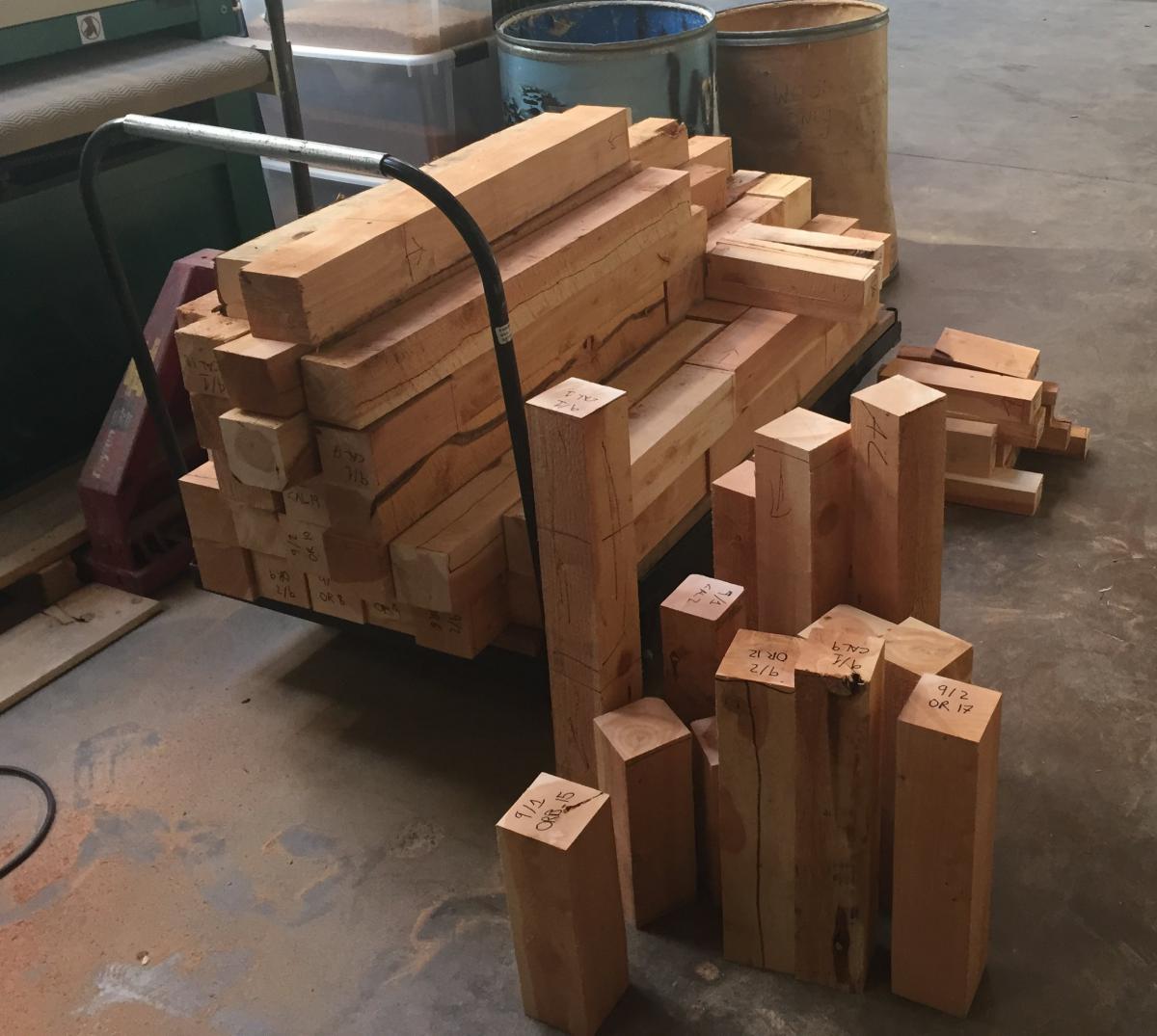
Samples being cut and examined for clear testing specimens.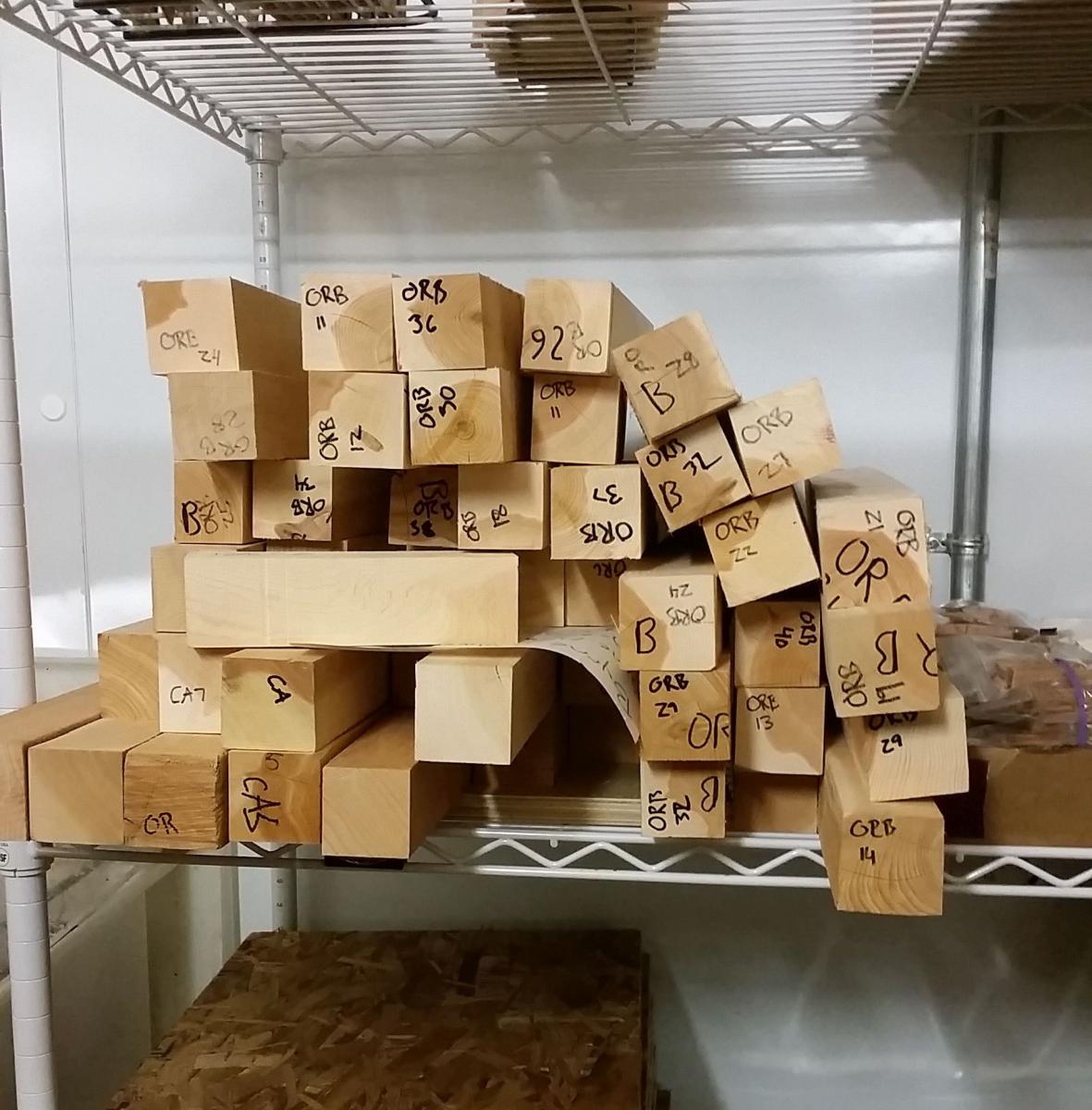
Bending specimens in the conditioning chamber.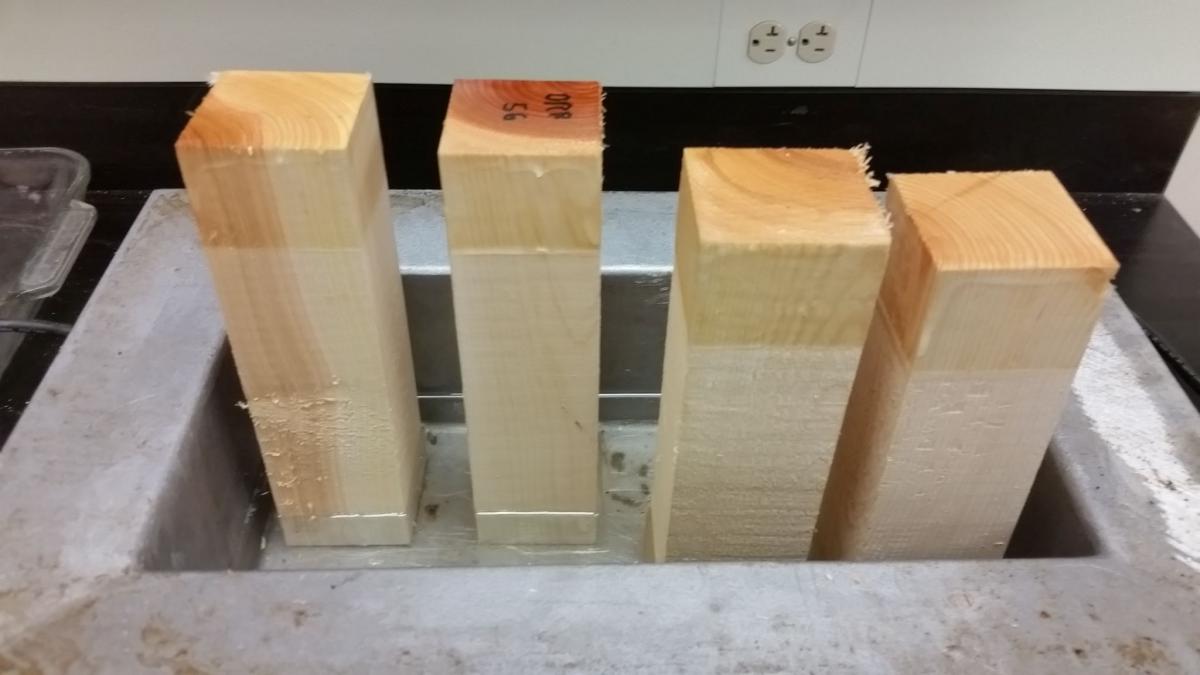
Applying wax to the end of test specimens to prevent end checks from forming.
Graduate student Byrne Miyamoto placing bending specimen for testing
Bending test 1/14/2016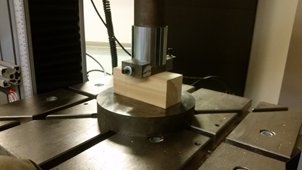
Compression perpendicular to grain testing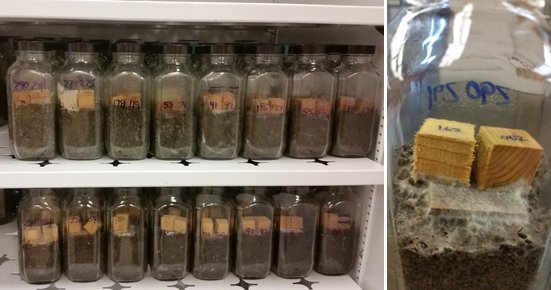
Soil block testing
